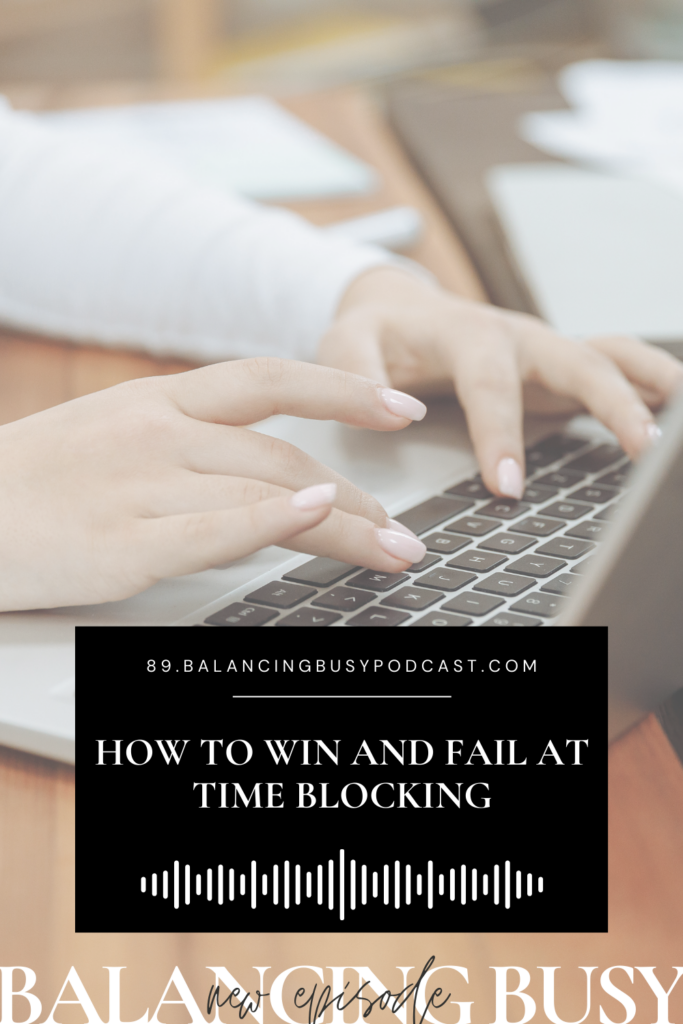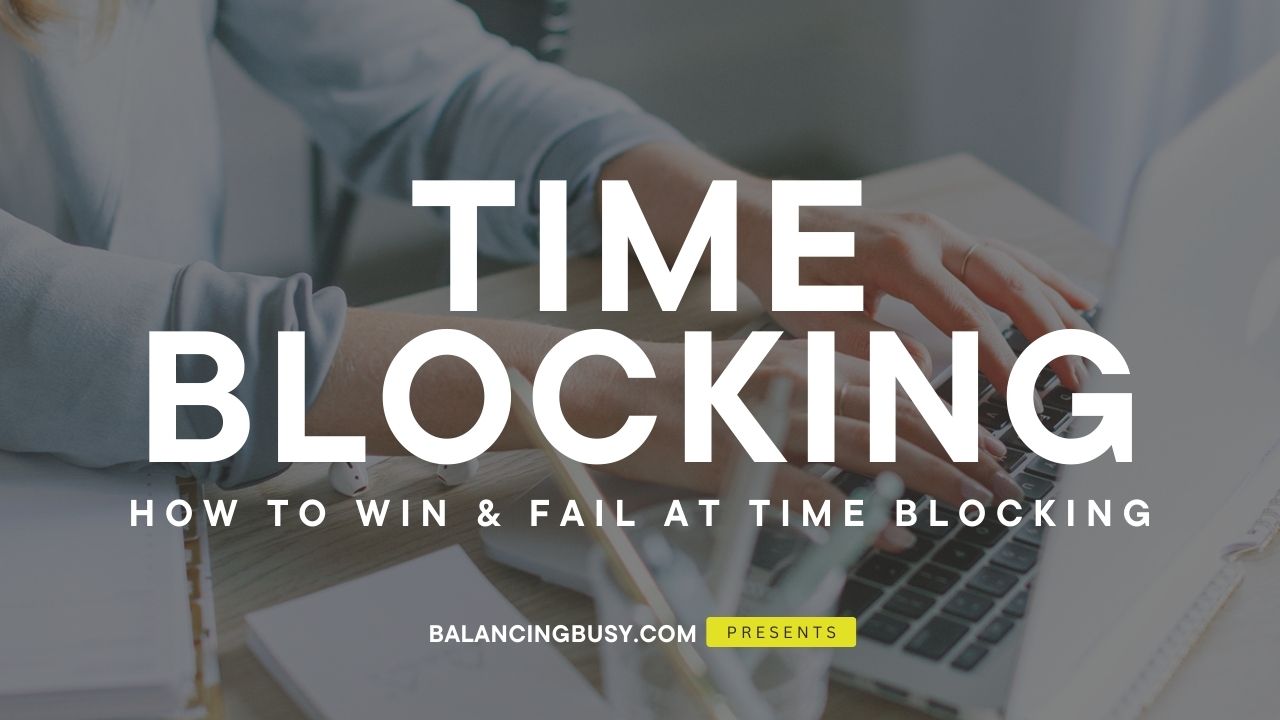[00:00:00] Hello, I’m Leah Remillet. This is the Balancing Busy podcast. And this week I am doing something completely different and I’m so excited. So everything around here is about how to, well, obviously balance the busy, how to feel more productive, how to get more done in less time and just end the day feeling like.
[00:00:25] Leah: You had a great day. You got things done. You can feel good about how the day went. I think we’ve all experienced those days where you never stop moving and yet you get to the end of the day and you’re like, I don’t even know. I don’t know what I did. I don’t know what happened. Well, this week I am going to share my favorite productivity strategies.
[00:00:44] Leah: You’ve heard them. You’ve probably used them. I’m going to give you my. Mom take on how I use these and what they are so that you can have more productivity in your life. So we are just going to go through them and they’re each going to be a mini episode so that you can just listen to that concept. You can listen to it with your kids, help them understand them.
[00:01:06] Leah: You can listen to them with your team. You can refer back to them and give them all a try. Maybe even try them in a new way. I’m so excited. Let’s jump in. Okay, when we’re talking about productivity, the first concept we’re going to talk about in this episode is going to be the time blocking method. So this is.
[00:01:24] Leah: Literally and simply just allocating where your time is going to be spent. This is especially powerful for anyone who, like I said just a minute ago, gets to the end of the day and they never stopped, but they’re not really sure what they did. If you relate to that, if you’re like, Oh my gosh, yes, I have.
[00:01:44] Leah: So many days that feel like that, time blocking can really help you. Now, the most popular form of time blocking is just establishing what you need to do in a day, what your priorities are, and then assigning each of those things that you want to accomplish. A amount of time, so you’re allotting how much time you think it’s going to take, and then you fit it in to your schedule for that day.
[00:02:10] Leah: So, maybe I say, I need to research for the podcast, I think that’s going to take 30 minutes, and then I’m going to record two episodes, I think that’s going to take an hour, and then I have a meeting, and that’s really obvious. That’s going to take one hour and then I’m going to have lunch. That’s going to take 30 minutes.
[00:02:29] Leah: And then I want to work on that other project. And I think that’s probably going to take 45 minutes. And then I just place them in my day. And now I know exactly how my day is going to work. Now, some people take time blocking so far that from the moment they wake up, they assign something in every single minute of the day.
[00:02:50] Leah: So wake up, breakfast, and they just keep going. And I have definitely had days where I have been that. meticulous and that specific about how the day is going. And I will say they are incredibly, incredibly productive days. I find that for my personality, I can’t do that every single day. It becomes. Too rigid.
[00:03:11] Leah: There has to be flexibility in there for me. But some days, some weeks, when it’s a really, really big week, that actually really does work for me and, and I’ve used it.
[00:03:21] Leah: But I’ve also found that there’s actually three forms of time blocking that I seem to use. So the first is the traditional way of just scheduling all of my tasks throughout the day into blocks, what we just talked about. But there’s two other ways that I use it. One is day theming. block an entire day to be around one specific task.
[00:03:43] Leah: Mondays are for the home, and I’m going to spend that whole day working on maybe house care stuff. Or maybe I say Wednesdays are my client meetings day, and I stack all my meetings just on Wednesdays. Or maybe I say Friday is my marketing day, and I spend Fridays just for marketing. So you can see how giving an entire day a theme.
[00:04:05] Leah: Then I would break that down. And I would say, okay. Based on that goal, let’s say this project, what, what things need to happen. And I would figure out what tasks need to happen, and then I’d block those in. The third way to use time blocking is task batching. And this is actually going to go into the next episode really well.
[00:04:25] Leah: But I take several of the same thing and I block them in together. This way I can get more done in less time. I’m in the zone. I’m in that mode. And I can just power. through. One of the most obvious ways that we use this would be things like social media content creation, or when I’m recording podcasts, I’m going to record all of these mini podcasts all at once right now.
[00:04:48] Leah: I just started, I’m going to power through. That’s why I’m not going to be wearing anything different than this for. All of these episodes, cause I am batching them and I’m blocking out time. I know that I have to be even more specific. I know that I have till 11. And so I had blocked my first amount of time for finishing up, writing out and making the bullets of what I wanted to say.
[00:05:11] Leah: And now I’ve got an hour and I’m going to record. And I know I have a hard stop at 11 because I have a meeting and there is me truly time blocking the day. Now, I thought it would actually be really helpful to also offer how to fail at each one of these strategies. So we hear constantly, here’s how to use it, here’s how to use it.
[00:05:33] Leah: I can also tell you how to fail because I’ve definitely failed using them. So here’s what I find will help you fail if you’re trying to utilize time blocking. Number one, being too rigid. If you are too rigid for too long, you’re going to rebel and resist and not want anything to do with it. So being too rigid can definitely help you fail at time blocking.
[00:05:53] Leah: Number two, you don’t schedule in buffers. One of the big rookie mistakes with time blocking is Here’s the bottom line. You are guessing at how long you think each thing is gonna take. Some things are very, very clear. I have a meeting. It’s scheduled for an hour. It’s gonna be an hour. But the majority of what I’m trying to block into my schedule, I don’t actually know how long it’s gonna take.
[00:06:15] Leah: I’m guessing. And we typically think things are gonna take way less time than they do. So if you don’t give yourself enough buffer, then You end up feeling really frustrated because even with the time blocks, you’re behind because you didn’t get enough done in that block as you thought you would. The other problem is if you set a block of time and then you decide to open email or check social media or any other of, you know, a plethora of distractions, now you’ve cut down that time and you’re going to fail and you’re going to feel frustrated.
[00:06:46] Leah: So scheduling buffers is really critical for being successful at time blocking. And the last thing is having completely unrealistic expectations of how long things are going to take.
[00:06:59] Leah: Like I just shared. And the easiest way to fix this is to actually track your time so that. You get better at understanding how long things take. But if you’re just starting with time blocking, just assume it’s gonna take longer than you think. Add on more time. I love to gamify for myself and I say, okay, I think this is gonna take an hour.
[00:07:17] Leah: But if I get done in less than an hour, then I get to use whatever time is left over for And I fill in whatever, whatever it is I want to do. And that helps me to stay on task, to use the time block, and to give myself more time than I think and see if I can beat it. And the honest truth is usually I don’t beat it because I didn’t give myself enough time and I needed the entire amount I gave myself.
[00:07:40] Leah: But sometimes that’s not true. , but either way, I won because I got the work done and time blocking can help us do that.
[00:07:50] Leah: Here’s why time blocking works. It eliminates multitasking, which has been proven to actually not be effective. It helps us to not feel so compelled to lean into distraction because We have a finite amount of time to work on this thing, and then we know we’re moving on to the next thing.
[00:08:09] Leah: And finally, it helps us to just see exactly where our day is and have a real grasp on if we’re trying to fit way too much into a day. If you block out your day, you say, I want these five things done, and they each take five hours. Then you look and go, okay, this is completely unreasonable. There’s no way I can do this.
[00:08:28] Leah: So it helps us to. Also be able to see our day with more clarity and know if what we’re trying to accomplish is actually possible. Okay, that’s time blocking. We’re jumping into the next one.
Hide Transcript


you said: